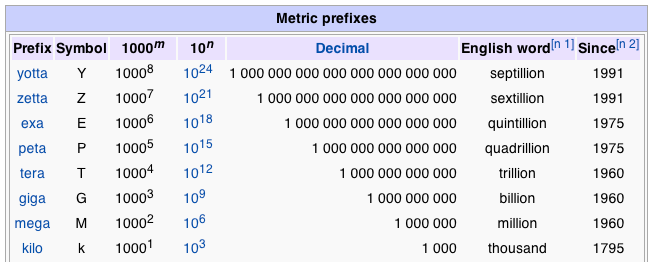Living in a land of large numbers: How to get a grip
This year, as we are bombarded by politicians’ promises ahead of important elections worldwide, I hear ever larger monetary values bandied about. How they will fix what they hadn’t bothered to do when in post; improve ‘the ordinary person’s’ (a pet hate phrase of mine) lot; create jobs and ‘grow the economy’. Yeah, right!
Million and billion are easily confused, especially as British and US definitions vary and have changed over time. Billion today is usually understood as one thousand million (the US version and another example of the dreaded American creep). UK-based financial dealers used to call this a ‘yard’, from the French ‘milliard’, and numerical vocabulary only created new words when current vocab couldn’t cope. So not until one got to a million million did we Brits use the word billion.
Technical analysts know that size matters. From a Marabuzo candle, to the height of the spike on a shooting star or hammer, the engulfing pairs of candles and the gravestone doji. Some of us invent new names of numbers for effect, like ‘squillion’, ‘zillion’ and ‘gazillion’. Others are vague and flexible, like ‘myriad’ and ‘loads’ [of money AKA wad]. Landscape artist Patrick Grant writes that in the British Domesday Book the size of a woodland was measured by the amount of pigs it could sustain, not acres. In the Western USA one ‘bit’ used to be worth 12.5 cents of a dollar; today it means anything small like coins, pieces of food or whatever. The phrase ‘rule of thumb’, I’m told, comes from the thickness of the stick with which a man could discipline a woman.
The Argentine people are flexible and creative in their use of large numbers having lived through umpteen bouts of hyperinflation. Amounts are open to discussion and the black market is in everyday use. Accounting is considered yet another of the creative arts, on a par with philosophy and poetry. There are slang words for loosely defined quantities: mango, gamba, luca and palo in ascending order. These aren’t fixed monetaryamounts, but values linked to the quantity of goods they buy. Akin to our use of bunch, handful, splash and dash.
Not to be outdone, Brazil has had nine different currencies since 1942. Names – usually based on the cruzeiro and the real and their variations – new notes were printed subsequent to the lopping off of three zeros. Since 1994 the current real has remained in circulation, helping the nation move into the realm of leading G20 and top tier emerging market countries. Still they use the word ‘mixaria’ which means pennies, peanuts, next to nothing.
Taken from Britannica online:
Large numbers are numbers above one million that are usually represented either with the use of an exponent such as 109 or by terms such as billion or thousand millions that frequently differ from system to system. The American system of numeration for denominations above one million was modelled on a French system, but in 1948 the French system was changed to correspond to the German and British systems. In the American system each of the denominations above 1,000 millions (the American billion) is 1,000 times the preceding one (one trillion = 1,000 billions; one quadrillion = 1,000 trillions). In the British system each of the denominations is 1,000,000 times the preceding one (one trillion = 1,000,000 billions) with the sole exception of milliard, which is sometimes used for 1,000 millions. In recent years British usage has reflected widespread and increasing use of the American system.
| value in powers of ten | number of zeros | American name | British name |
| 109 | 9 | billion | thousand million or milliard |
| 1012 | 12 | trillion | billion |
| 1015 | 15 | quadrillion | thousand billion |
| 1018 | 18 | quintillion | trillion |
| 1021 | 21 | sextillion | thousand trillion |
| 1024 | 24 | septillion | quadrillion |
| 1027 | 27 | octillion | thousand quadrillion |
| 1030 | 30 | nonillion | quintillion |
| 1033 | 33 | decillion | thousand quintillion |
| 1036 | 36 | undecillion | sextillion |
| 1039 | 39 | duodecillion | thousand sextillion |
| 1042 | 42 | tredecillion | septillion |
| 1045 | 45 | quattuordecillion | thousand septillion |
| 1084 | 84 | quattuordecillion | |
| 10100 | 100 | googol | googol |
| 10303 | 303 | centillion | |
| 10600 | 600 | centillion | |
| 10googol | googol | googolplex | googolplex |
Tags: Million, money, quantity
The views and opinions expressed on the STA’s blog do not necessarily represent those of the Society of Technical Analysts (the “STA”), or of any officer, director or member of the STA. The STA makes no representations as to the accuracy, completeness, or reliability of any information on the blog or found by following any link on blog, and none of the STA, STA Administrative Services or any current or past executive board members are liable for any errors, omissions, or delays in this information or any losses, injuries, or damages arising from its display or use. None of the information on the STA’s blog constitutes investment advice.
Latest Posts
- Trust Me, I’m a Technical Analyst by Trevor Neil: Why Charting Is as Important Now as Ever October 15, 2025
- Why Networking Still Matters: Reflections from the STA Drinks at the National Liberal Club October 2, 2025
- Fireside Wisdom: Clive Lambert in Conversation with Tony LaPorta September 10, 2025
- Understanding Triple RSI Divergence: A Potential Warning Sign for the S&P 500 September 1, 2025
- Unlock Your Potential in Finance: Join the Society of Technical Analysts – No Qualifications Required July 24, 2025





















Latest Comments